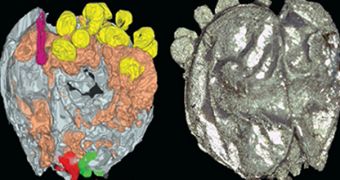While conducting investigation at a dig site near Rome, in New York, investigators from the Yale University and the University of Leicester in England discovered the fossilized remains of multiple small ostracod specimens, ancient crustaceans that were buried and fossilized alongside their eggs and newly-hatched offspring. The team says one of the creatures belongs to an unknown species.
The tiny crustaceans were determined to have lived around 450 million years ago, in the Paleozoic Era. At that time, sea levels were 154 meters (505 feet) higher than they are now and atmospheric oxygen concentration was just 17 percent (80 percent of current levels). These creatures lived long before the earliest known land, air-breathing animal, which dates back to 428 million years ago.
According to the research team, these ostracods are the ancestors of modern-day phylum called arthropods, which contains insects, arachnids such as spiders, scorpions, and crustaceans. The specimens discovered in the new study were fossilized after a mudslide unexpectedly covered them up. At that time, this entire region was under water.
One particular ostracod individual was an adult female, which was buried with both eggs and early embryos, providing researchers with a perfect window into the species she belonged to. Instances where such fossils are nearly perfectly preserved are extremely rare in the fossil record, says expert Derek E.G. Briggs, one of the authors on the new study.
The investigation is detailed in the March 13 issue of the esteemed journal Current Biology. Briggs holds an appointment as the director of the Yale Peabody Museum of Natural History. The first author of the paper is expert David Siveter, from the University of Leicester. The team says that ostracods are easily the most abundant fossil arthropods in the record.
Thanks to the new discovery, scientists have now extended the age range for these creatures by about 25 million years and have confirmed for the first time that they lived in the Ordovician period of the Paleozoic Era, between 485 and 443 million years ago. Brood caring as a natural habit therefore has the longest history of any types of intra-species caring behaviors in the world.
“Only a handful of examples are known where eggs are fossilized and associated with the parent. This discovery tells us that these ancient tiny marine crustaceans took particular care of their brood in exactly the same way as their living relatives,” Siveter explains. He explains that the new study has revealed no less than 100 new ostracod specimens.
In the new Current Biology paper, entitled Exceptionally Preserved 450-million-year-old Ordovician Ostracods with Brood Care, the team also reports the discovery of a new ostracod species, which has been named Luprisca incuba. Inspiration for the name was taken from the Roman goddess of childbirth, Lucina.

 14 DAY TRIAL //
14 DAY TRIAL //